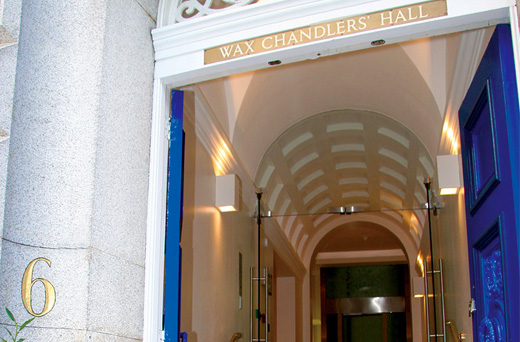The Wax Chandlers’ Company presents each year the altar candles for St Paul’s Cathedral. This takes place on Holy Cross Day, 14 September, and the significance of this date to both the Cathedral and the Wax Chandlers is set out below.
From some time before 1371, but after 1300, pre-Reformation wax chandlers used to contribute a pound of beeswax for the maintenance of the Company’s great taper which was sited before the Crux Borealis, or Rood at the North Door, of the mediaeval cathedral. Tradition had it that the Rood had been carved by St Joseph of Aramithea, and it is sometimes claimed that the relic had been discovered in the Thames following a flood during the time of King Lucius – if not actually found by King Lucius himself.
The connection with wax chandlery is not immediately obvious today. Why would the mediaeval wax chandlers have chosen to focus their devotions on this relic?
If medieval people considered that the purpose of life was to prepare for heaven, it can be claimed that the trade of the wax chandler aided people in trying to get to heaven; the burning of vast amounts of beeswax was an essential part of observances intended to speed the passage of (designated) souls through Purgatory and into heaven. The wax chandler also supplied the accessories for a funeral – the hearse, the embalming of the corpse, and so on, much of which would fall to the modern undertaker to provide.
Joseph is sometimes described as the patron saint of undertakers, he having provided the Holy Sepulchre. So he is an appropriate link.
The medieval visitor to St Paul’s would know of the tradition connecting the crucifix with Joseph of Aramithea.
King Lucius has been associated with a tradition of the conversion of Britain to Christianity in the late second century. Few nowadays would argue that King Lucius was a real historical figure, although he is connected with many English and Welsh sites where an infusion of ancient Britain was thought desirable. For example, Cambridge University used to claim that he had converted 3000 philosophers at the University. His real name was Llewrug Mawr, apparently meaning “the Great Light”, and Lucius is the Latinised version denoting his purported rôle as the bringer of light (Christianity) to these shores. So not an inappropriate connection, even if there seems to be a lack of ancient evidence to support it.
There are three other angles to this connection:
1. The tradition of the mission of Joseph of Aramithea is central to the Glastonbury legends including those surrounding King Arthur. It is interesting to note that these legends enjoyed a period of popularity around the end of the thirteenth century, and there is a connection around this time with the Round Table at Winchester.
One of the Royal officials involved with the Round Table was John de Droxenford, a native of the Winchester area, Keeper of the Kings Wardrobe – and hence the official responsible for the Royal Chandlery. Almost all the early wax chandlers who had surnames denoting where they came from seem to have come from the Winchester area.
2. These traditions make claims that the English Church predated the Church based in Rome and that it had apostolic origins – a point not lost on the reformers who, in the sixteenth century, often used the tradition of King Lucius to this end. It also links with the “New Troy” legend concerning the City’s foundation by Trojan refugees long before Rome was founded. (Venice made similar claims against Rome.)
3. The tradition was also invoked as showing God’s providential concern for the English, and perhaps it is worth noting that in the fourteenth century we can see evidence of a growing sense of national identity and of hostility – certainly in the City – to Italians.


